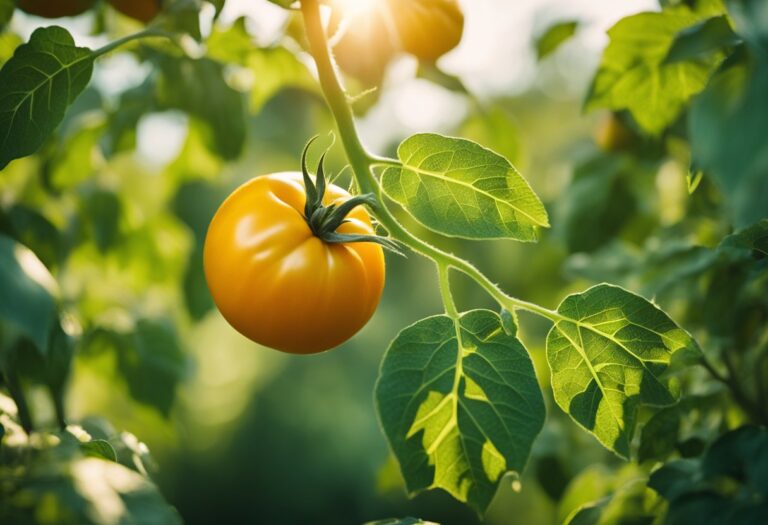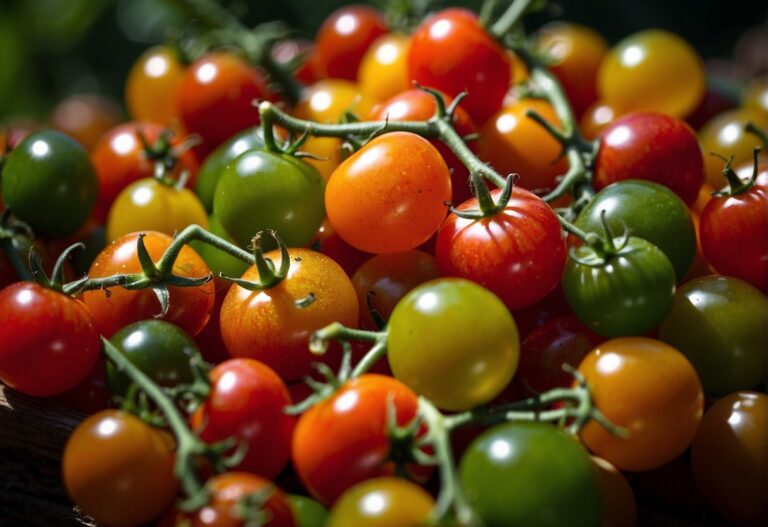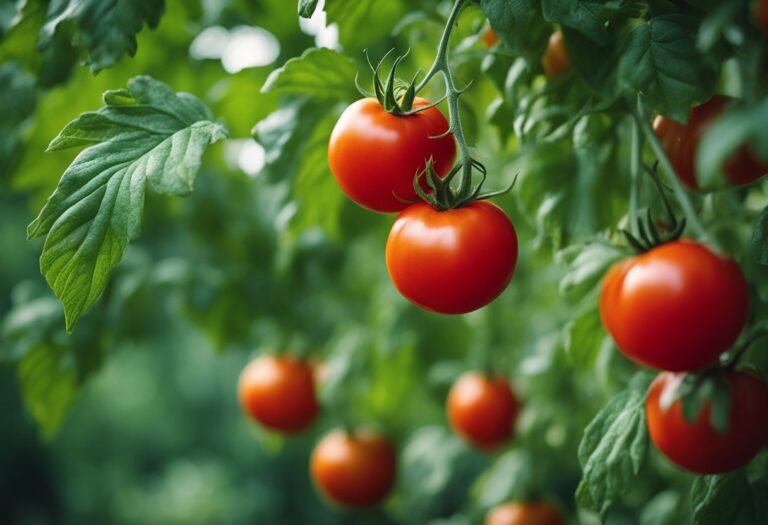Oregon Spring Tomato: A Guide to Growing and Harvesting in the Pacific Northwest
If you’re looking for a tasty and versatile tomato to add to your garden, the Oregon Spring Tomato might be just what you need. This variety of tomato is a popular choice among gardeners due to its early maturity and high yield.
With a meaty texture and a sweet, rich flavor, Oregon Spring Tomatoes are perfect for a variety of dishes, including salads, sauces, and more.

To successfully grow Oregon Spring Tomatoes, you’ll need to understand the specific cultivation techniques that work best for this variety. From choosing the right soil and planting location to providing adequate sunlight and water, there are a few important steps to follow.
Once your tomatoes are ready to harvest, you’ll also need to know the best methods for storing and using them in your favorite recipes. Whether you’re a seasoned gardener or just starting out, the Oregon Spring Tomato is a great choice for anyone looking to add some fresh, homegrown produce to their meals.
Key Takeaways
- The Oregon Spring Tomato is a popular and versatile variety of tomato that is known for its early maturity and high yield.
- To successfully grow Oregon Spring Tomatoes, it’s important to understand the specific cultivation techniques that work best for this variety, including soil, sunlight, and water requirements.
- Once harvested, Oregon Spring Tomatoes can be used in a variety of recipes and should be stored properly to ensure maximum freshness and flavor.
Understanding the Oregon Spring Tomato

If you’re looking for a tomato variety that can withstand cold temperatures while still producing a good yield, the Oregon Spring tomato might be just what you need.
This tomato variety is known for its ability to ripen early and produce fruit even in chilly environments. In this section, you’ll learn more about the history, characteristics, and varietal differences of the Oregon Spring tomato.
History and Origin
The Oregon Spring tomato was developed by Dr. James Baggett at Oregon State University in the 1980s. Dr. Baggett was looking for a tomato variety that could produce fruit in cool, damp conditions, which are common in the Pacific Northwest. After several years of crossbreeding different tomato varieties, he came up with the Oregon Spring tomato.
Characteristics
The Oregon Spring tomato is a determinate tomato plant, which means it grows to a certain height and then stops. This makes it easier to manage and harvest. The fruit of the Oregon Spring tomato is medium-sized, with a round shape and a bright red color when ripe.
The skin of the fruit is thin and delicate, while the flesh is tender and juicy. This tomato variety is known for its low acidity and sweet, complex flavor.
Varietal Differences
While all Oregon Spring tomatoes share certain characteristics, there can be some variation in the fruit depending on the specific variety. For example, some varieties may produce larger or smaller fruit than others.
Additionally, some varieties may be more resistant to certain diseases or pests than others. When choosing an Oregon Spring tomato variety to grow, it’s important to consider your specific growing conditions and needs.
In summary, the Oregon Spring tomato is a unique and versatile tomato variety that can thrive in cool, damp environments. Whether you’re a home gardener or a commercial grower, this tomato is worth considering for its early ripening, sweet flavor, and low acidity.
Cultivation Techniques

Soil Preparation
To ensure a healthy crop of Oregon Spring Tomatoes, you need to prepare the soil adequately. Start by selecting a location that receives plenty of sunlight. Then, till the soil to a depth of at least 8 inches.
Next, add compost to the soil to increase its nutrient content. You can also add biochar to the soil to improve its water retention capabilities. Finally, mix the compost and biochar into the soil.
Planting
Plant your Oregon Spring Tomato seedlings after the last frost has passed. Dig holes that are around 2 feet apart and deep enough to accommodate the seedlings’ root balls.
Place the seedlings into the holes and cover them with soil. Water the plants immediately after planting.
Watering and Nutrients
Water your Oregon Spring Tomatoes regularly, but be careful not to overwater them. Overwatering can lead to root rot and other fungal diseases.
Fertilize your plants with a balanced fertilizer every two weeks. Be sure to follow the manufacturer’s instructions for the correct dosage.
Pest and Disease Management
To keep pests and diseases at bay, you can use Bacillus thuringiensis (Dipel) sprays. Planting flowers and insectary plants near the borders or in your garden will attract beneficial insects.
Keep an eye out for signs of pests and diseases, such as yellowing leaves or spots on the fruit. If you notice any issues, take action immediately to prevent the problem from spreading.
Remember that growing Oregon Spring Tomatoes takes time and effort, but the results are worth it. By following these cultivation techniques, you can increase your chances of a healthy and bountiful harvest.
Harvesting and Storage
When to Harvest
To get the most flavorful and juicy Oregon Spring Tomatoes, it’s important to harvest them at the right time.
Wait until the fruits are fully mature and have a deep red color. If you’re unsure whether your tomatoes are ripe, gently squeeze them. If they give slightly to the touch, they’re ready to be picked.
How to Harvest
When harvesting Oregon Spring Tomatoes, use a sharp knife or pruning shears to cut the stem just above the fruit.
Be careful not to damage the fruit or the plant. If you’re picking a large number of tomatoes, you may want to use a basket or a bucket to collect them.
Post-Harvest Handling
After harvesting, remove any damaged or diseased fruits to prevent the spread of bacteria and fungi. If you notice any cracks or bruises on the tomatoes, use them as soon as possible or store them separately from the healthy fruits.
Storage Tips
To extend the shelf life of your Oregon Spring Tomatoes, store them in a cool, dry place away from direct sunlight. Do not refrigerate the tomatoes, as this can cause them to lose their flavor and texture. If you have a large harvest, you may want to consider canning or freezing the tomatoes for later use.
Remember, the key to enjoying the delicious taste of Oregon Spring Tomatoes is to harvest them at the right time and handle them with care.
Usage and Recipes
Fresh Consumption
Oregon Spring Tomatoes are a great addition to any salad or sandwich. Their moderate tart taste, juicy and meaty flesh, and full flavor make them perfect for fresh consumption.
You can also pair them with olives, feta cheese, and cucumbers to make a delicious salad. If you prefer to eat them as a snack, you can cut them into slices and sprinkle some salt and pepper.
Cooking Ideas
Oregon Spring Tomatoes are versatile and can be used in a variety of dishes. They are great for making sauces, salsa, and tomato soup.
You can also use them as a topping for pizza or as a filling for a quiche. If you want to preserve their flavor and nutrients, you can can them or make tomato paste.
Here are a few recipe ideas for Oregon Spring Tomatoes:
- Tomato and Basil Bruschetta: Toast some bread and top it with chopped Oregon Spring Tomatoes, fresh basil, and garlic. Drizzle some olive oil and balsamic vinegar on top.
- Tomato and Mozzarella Salad: Slice some Oregon Spring Tomatoes and fresh mozzarella cheese. Arrange them on a plate and sprinkle some chopped basil, salt, and pepper. Drizzle some olive oil and balsamic vinegar on top.
- Tomato and Vegetable Soup: In a pot, sauté some chopped onions, garlic, and carrots. Add some chopped Oregon Spring Tomatoes, vegetable broth, and your favorite vegetables. Simmer until the vegetables are tender. Serve with some crusty bread.
Remember to always wash your Oregon Spring Tomatoes before using them. Enjoy!
Health Benefits and Nutrition
Oregon Spring Tomatoes are a great source of vitamins and minerals that are essential to maintaining a healthy diet. These tomatoes contain high levels of Vitamin C, which is important for maintaining a healthy immune system. Additionally, they are rich in potassium, which helps to strengthen your muscles and maintain healthy blood pressure levels.
One medium-sized Oregon Spring Tomato contains approximately 22 calories, making it a great addition to any low-calorie diet. They are also low in fat and high in fiber, which helps to keep you feeling full and satisfied for longer periods of time.
In addition to being a great source of essential vitamins and minerals, Oregon Spring Tomatoes are also rich in antioxidants. Antioxidants help to protect your body against harmful free radicals, which can contribute to the development of chronic diseases such as cancer and heart disease.
Overall, incorporating Oregon Spring Tomatoes into your diet is a great way to maintain a healthy lifestyle. Whether you enjoy them sliced on a sandwich or diced in a salad, these tomatoes are a delicious and nutritious addition to any meal.
Frequently Asked Questions
What are the best conditions for growing Oregon Spring tomatoes?
To grow Oregon Spring tomatoes successfully, you need to provide them with full sun exposure, fertile soil that is well-draining, and consistent moisture.
The ideal temperature for growing this variety of tomato is between 60 to 75 degrees Fahrenheit. Oregon Spring tomatoes are also tolerant to cold weather, making them a great option for gardeners in cooler climates.
How do you care for Oregon Spring tomatoes in a container setting?
If you are growing Oregon Spring tomatoes in a container, make sure to choose a container that is at least 18 inches deep and 24 inches wide. Use high-quality potting soil and make sure the container has adequate drainage.
Water the plants regularly and fertilize them every two weeks with a balanced fertilizer. Prune the plants regularly to promote good airflow and prevent disease.
Is the Oregon Spring tomato variety considered heirloom or hybrid?
The Oregon Spring tomato is a hybrid variety that was developed by Dr. James Baggett at Oregon State University in the 1980s. It was created to be an early-maturing tomato that could tolerate cooler temperatures than other varieties.
What makes Oregon Spring tomatoes tolerant to cold weather?
Oregon Spring tomatoes are tolerant to cold weather because they were specifically bred to be an early-maturing tomato that could withstand cooler temperatures.
They have a shorter growing season than other tomato varieties, which makes them well-suited for cooler climates.
What is the typical size of an Oregon Spring tomato fruit?
Oregon Spring tomatoes are small to medium-sized tomatoes that are about 1 to 2 inches in diameter.
They are round and have a glossy, medium-red color when ripe. The fruits have a meaty texture and a sweet, rich tomato flavor.
How should Oregon Spring tomato plants be spaced in the garden?
When planting Oregon Spring tomatoes in the garden, space the plants about 2 to 3 feet apart to allow for good airflow and prevent disease.
Make sure the plants are in a location that receives full sun exposure and has well-draining soil. Water the plants regularly and fertilize them every two weeks with a balanced fertilizer.




